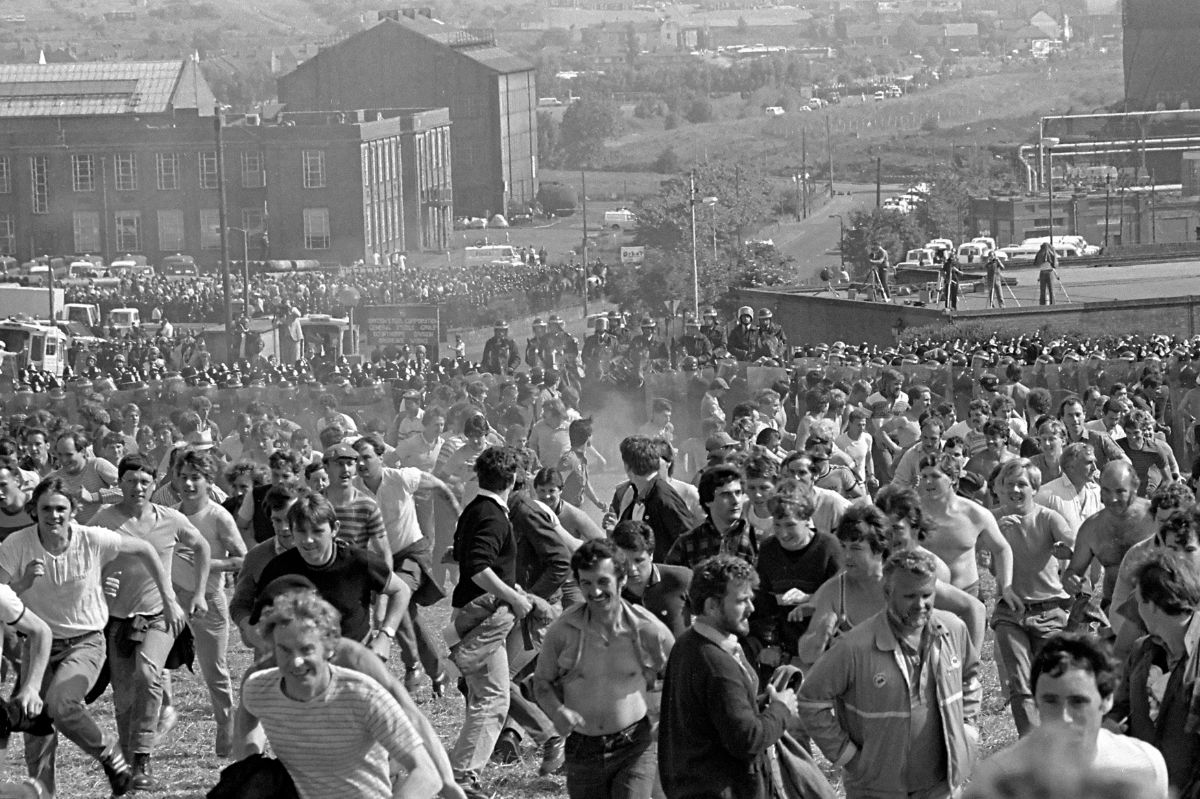A year on the frontlines of the UK miner’s strike
- Text by Miss Rosen
- Photography by Martin Shakeshaft

In 1984, Martin Shakeshaft was ready for a career change. He was in his mid-20s, working in the NHS as a nurse, but had become disillusioned by lack of funding and resources. “Some things never change,” he says today.
He decided to take a chance and applied for the Documentary Photography program at Newport – run by Magnum Photos member David Hurn. Luckily, Shakeshaft was one of the 12 students accepted.
Inspired by the work of Jo Spence and W. Eugene Smith. Shakeshaft recognised that photography could be used as a tool for activism. “I was very political at the time… I was using a camera to record the world around me, and in a way to help me make sense of it,” he says. “I had a strong sense of justice and couldn’t understand why everyone else didn’t feel the same.”

Orgreave Coking Plant. Near Sheffield, 18 June 1984
When the UK Miners’ Strike began, Shakeshaft headed to the frontlines to document it. His new book, The Miners’ Strike 1984–1985 (Café Royal Books), revisits that fateful year.
Shakeshaft got his start publishing photos of picket lines in political newspaper. But as he got to know the miners, he realised there was a bigger story to tell. “In addition to ‘headline events’, we began to cover what was actually happening in the communities,” he remembers.
During this process, he became close with a miner named Peter Harries. “I used to stay with him and his family in the town of Maerdy. Peter wouldn’t be classed as overtly political, but had no doubts that he was trying to preserve the future of his community. I got a real sense of the camaraderie that the miners felt for each other.”
As the strike continued, it divided the country. “After the previous Tory Government had been bought down by strike action in what had become known as the ‘Winter of Discontent’, Thatcher knew this was a battle she had to win. So the full power of the state was used to defeat the strike,” says Shakeshaft.

Miners and Labour Party Young Socialists demonstrate at the Conservative Party Conference, 1984

Police Horses Charge Through Miners Picket Line. Orgreave Coking Plant. Near Sheffield, 18 June 84
He quickly noticed the discrepancy between media coverage and actual events. Shakeshaft would get home in the evening after photographing on the picket lines, only to see a totally different versions of event played out on the news. He cites the 1984 Orgreave Riot, where 71 picketers were charged with riot and 24 with violent disorder, as an example.
“The BBC News stated that police horses were used to clear pickets, throwing stones at police lines. However, I was there and know that the police used horses and snatch squads against the miners long before a single stone was thrown. When the miners were charged with riot, some of my images where used by the defence to prove that the police had fabricated evidence against them.”
“At the time, riot was punishable by life imprisonment. The trials collapsed when the evidence given by the police was deemed ‘unreliable.’ As a photographer I am sometimes asked if ‘taking a photograph can make a difference’. In this case, it definitely did.”

Orgreave Coking Plant. Near Sheffield – 18 June 1984

Orgreave Coking Plant. Near Sheffield, 18 June 84

Alun ‘Massum’ Jones. The march back to work, Maerdy, 5 March 1985
The Miners’ Strike 1984–1985 is out now on Café Royal Books.
Follow Miss Rosen on Twitter.
Enjoyed this article? Like Huck on Facebook or follow us on Twitter.
You might like

On Alexander Skarsgård’s trousers, The Rehearsal, and the importance of weirdos
Freaks and Finances — In the May edition of our monthly culture newsletter, columnist Emma Garland reflects on the Swedish actor’s Cannes look, Nathan Fielder’s wild ambition, and Jafaican.
Written by: Emma Garland

A reading of the names of children killed in Gaza lasts over 18 hours
Choose Love — The vigil was held outside of the UK’s Houses of Parliament, with the likes of Steve Coogan, Chris O’Dowd, Nadhia Sawalha and Misan Harriman taking part.
Written by: Isaac Muk

Youth violence’s rise is deeply concerning, but mass hysteria doesn’t help
Safe — On Knife Crime Awareness Week, writer, podcaster and youth worker Ciaran Thapar reflects on the presence of violent content online, growing awareness about the need for action, and the two decades since Saul Dibb’s Bullet Boy.
Written by: Ciaran Thapar

Dalia Al-Dujaili: “When you’re placeless, nature can fill the void”
Babylon, Albion — As her new book publishes, the British-Iraqi author speaks about connecting with the land as a second-generation migrant, plants as symbols of resistance, and being proud of her parents.
Written by: Zahra Onsori

Meet the trans-led hairdressers providing London with gender-affirming trims
Open Out — Since being founded in 2011, the Hoxton salon has become a crucial space the city’s LGBTQ+ community. Hannah Bentley caught up with co-founder Greygory Vass to hear about its growth, breaking down barbering binaries, and the recent Supreme Court ruling.
Written by: Hannah Bentley

We are all Mia Khalifa
How humour, therapy and community help Huck's latest cover star control her narrative.
Written by: Alya Mooro

